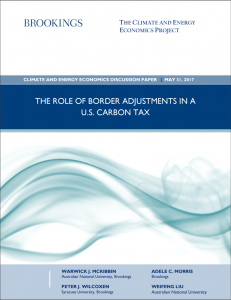Full Title: The Role Of Border Adjustments In A U.S. Carbon Tax
Author(s): Warwick J. Mckibbin, Adele C. Morris, Peter J. Wilcoxen, Weifeng Liu
Publisher(s): Brookings Institute
Publication Date: May 1, 2017
Full Text: Download Resource
Description (excerpt):
This paper examines carbon tax design options in the United States using an intertemporal computable general equilibrium model of the world economy called G-Cubed. Four policy scenarios explore two overarching issues: (1) the effects of a carbon tax under alternative assumptions about the use of the resulting revenue, and (2) the effects of a system of import charges on carbon-intensive goods (“border carbon adjustments”).
We first establish a baseline scenario in which the United States does not adopt a climate policy other than policies in place in early 2017. Then we model a simple excise tax on the carbon content of fossil fuels in the U.S. energy sector starting in 2020 at $27 per metric ton of carbon dioxide (CO2) and rising at 5 percent above inflation each year through 2050. We investigate two approaches to using the revenue: one that rebates the revenue to households in annual lump sum transfers (LS below) and one that applies the revenue to reduce the marginal tax rate on capital income (KT below). For each revenue policy, we run scenarios with and without a border carbon adjustment (BCA) on imports. The BCAs vary by country and good and account for the carbon emitted throughout the full production chain of the good in the country where it is produced.
Consistent with earlier studies, we find that the carbon tax raises considerable revenue and reduces CO2 emissions significantly relative to baseline, no matter how the revenue is used. Gross annual revenue from the carbon tax with lump sum rebating and no BCA begins at $110 billion in 2020 and rises gradually to $170 billion in 2040. By 2040, annual CO2 emissions fall from 5.5 billion metric tons (BMT) under the baseline to 2.4 BMT, a decline of 3.1 BMT, or 57 percent. Cumulative emissions over 2020 to 2040 fall by 48 BMT.
Also consistent with earlier studies, we find that the carbon tax has very small overall impacts on GDP, wages, employment, and consumption. Different uses of the revenue from the carbon tax result in slightly different levels and compositions of GDP across consumption, investment and net exports. Overall, using carbon tax revenue to reduce the capital income tax rate results in better macroeconomic outcomes than using the revenue for lump sum transfers. Indeed, even while achieving remarkable emissions reductions, the policy results in the U.S. economy reaching the output projections in 2040 only about three months later than it would without the carbon tax. With the rebates, consumption rises in the short run and then returns close to baseline in the medium to longer run. Investment falls sharply in the short to medium run and recovers somewhat in the long run, but remains about one percentage point below baseline. In contrast, the capital tax reduction has little effect on consumption in the short run and causes investment to rise briefly relative to baseline before it settles within a half percentage point from baseline in the long run.
Counter to their purported purpose of protecting U.S. trade strength, for a given revenue policy, BCAs tend to produce lower net exports than the carbon taxes alone. This is generally because the BCAs result in higher value of the dollar relative to other currencies, thus lowering exports more than they lower imports. This is consistent with standard results in the international trade literature on the effects of import tariffs and export subsidies on real exchange rates, a result that is often ignored in the discussion of domestic carbon policy.
In a finding new to the literature, our results show that BCAs can have strikingly different effects depending on the use of the revenue. The BCAs in the lump sum rebate scenario result in slightly lower domestic output than the same scenario without the BCAs, thus doing more harm than good — including in the relatively energy-intensive sectors like durable goods manufacturing. In contrast, BCAs tend to result in higher output than the carbon tax alone when the revenue is used to reduce other distortions in the economy.
